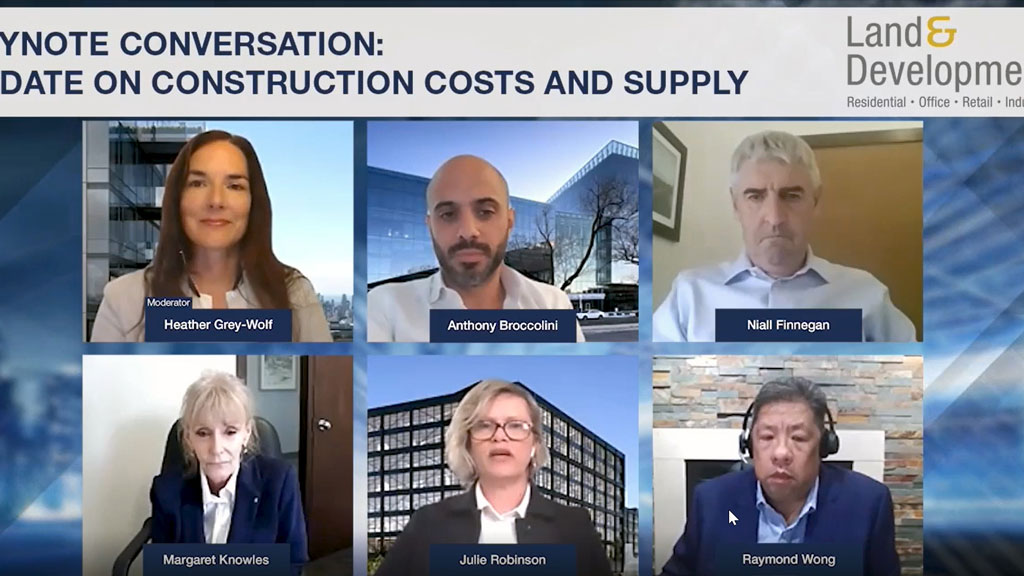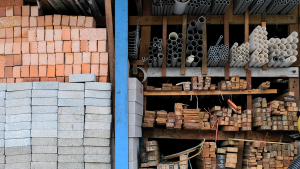Real estate development in Canada is a fraught and volatile industry right now with the big developers, contractors and consultants all dealing with sectoral uncertainty and rising costs on a scale not seen in some time.
That was the takeaway from a June 9 online panel discussion titled Update on Construction Costs and Supply, presented as part of the 2021 Land and Development Conference by Informa Canada.
Some sectors such as highrise residential and industrial are booming but retail construction faces an uncertainty and analysts are scratching their heads over what will happen with office development, panellists suggested.
But even with highrise construction costs having risen 50 per cent in the Toronto market in the past five years by some estimates and with productivity down significantly because of the pandemic, the construction sector has shown surprising resilience suggested panellist Julie Robinson, vice-president of construction at Hines.
“I think there are a lot of things that surprised me, but the biggest thing was how adaptable the contractors were to the pandemic,” said Robinson. “I just thought the sites were just going to wind right down…but they’ve managed to make it work.
“They’ve managed to social distance, and have a hoist running with three or four guys in a hoist, but their productivity, I’m hearing it’s in the range of 75 per cent so that surprised me the most.”
Panellist Niall Finnegan, co-founder of Finnegan Marshall Inc., outlined the effects of five years of rising costs in the Greater Toronto Area. His firm recently completed an analysis of two projects and found costs have gone up 53 per cent on highrise construction in the past half decade, mainly due to trade cost increases, especially formwork but also mechanical, windows, drywall and lumber-related trades such as finishing carpentry.
“Formwork costs haven’t really started escalating until about three years ago and then those of us who are involved day to day in the industry will appreciate that formwork costs right today are probably two and a quarter times what they were three years ago,” said Finnegan.
Fifty-three per cent works out to nine per cent a year compounded, he said, and the increase was greater over the past three years.
“However, what’s very interesting, and I want to point this out, is that in the same five-year period, soft costs have gone up about 68 per cent and land costs have probably gone up by our measurement about 140 per cent. So on a blended basis, project costs across the board are up about 76 per cent.”
City levies make up a lot of soft costs, Finnegan said.
Revenues in the highrise residential market tend to keep pace with costs so have significantly offset them, Finnegan said. But it’s a different story with retail explained panellist Margaret Knowles, senior vice-president at Morguard Investments.
“For the big enclosed malls that are costly to operate — that have the old anchors on them that control everything and don’t pay a lot of rent— it’s a tough, tough environment to be working in right now,” said Knowles.
Not all retail is suffering, she noted, but overall there has been a reduction in the expectations of institutional investors.
“It’s all tied in with interest rates and cap rates and all of that,” said Knowles. “At the end of the day, you’ve got to have that lease in place, paying X amount per square foot to generate that revenue. Right now there is a struggle in retail.”
While industrial, including warehousing, is “off the charts,” Knowles said, office investment was nowhere to be seen in the last year across Canada.
“Slowly, slowly the deals are starting to come but we certainly had a ton of tenants, big institutional-type tenants as well as banks and others, asking to sublet space, so the anticipation is among the tenants that we have is that there’ll be some kind of hybrid return to the workplace.
“And obviously that doesn’t bode well long term for office rates.”
Asked about mitigating cost risks, Broccolini COO Anthony Broccolini noted his firm has been very busy in the residential sector but that cost increases had kept his firm “on our toes.” He said the company ensures it gets its pricing right and locked in early. It has put even more emphasis on cultivating relationships and it has stayed disciplined and agile.
“You’ve got to be quick and you’ve got to have a good heartbeat of what’s really, really going on in the marketplace,” said Broccolini.
Knowles said other keys to survival are developing good relationships with city staff — these days there might be five different city departments to work with — and even before talking to the trades it’s important to assemble a good set of consultants who are experienced in the asset class and capable of “producing an excellent set of documents.”
Follow the author on Twitter @DonWall_DCN.











Recent Comments
comments for this post are closed